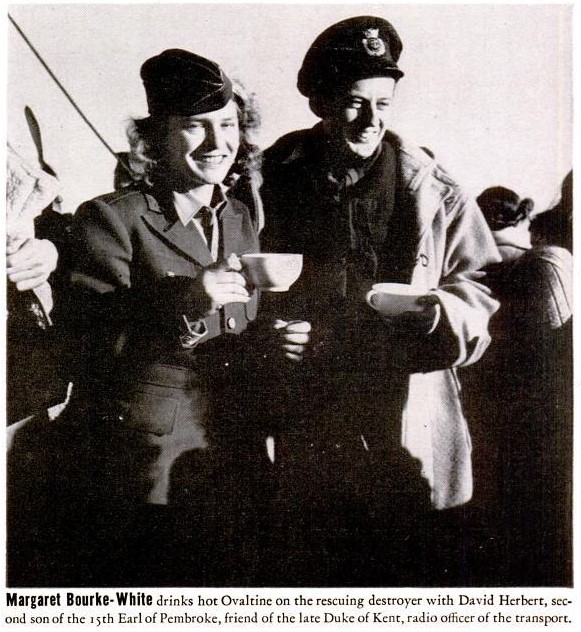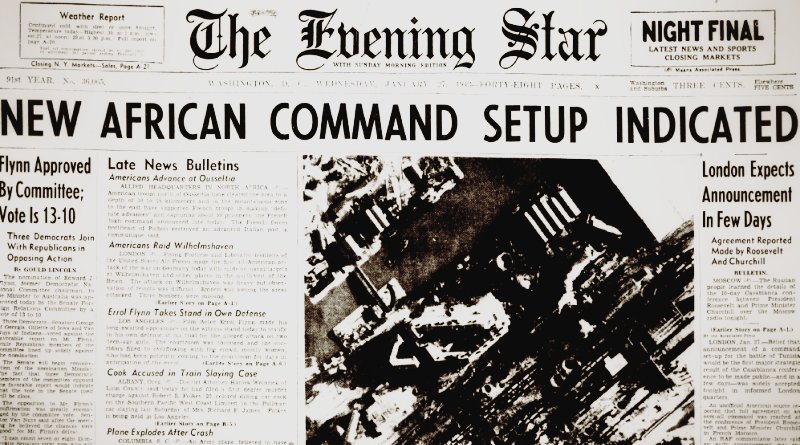World War II Chronicle: January 27, 1943
The first few pages discuss Pres. Roosevelt’s historic visit to French North Africa this month (see video below)… Last month we discussed Pharmacist’s Mate 1st Class Wheeler B. Lipe, the Navy corpsman who performed an emergency appendectomy aboard a submarine using kitchen utensils. Lipes is pictured today on page eight…
George Fielding Eliot column on page 12… Sports on page 20, and Cleveland manager Lou Boudreau thinks his Indians will be the American League team to beat this season, and says two-time All-Star Buddy Rosar is the best catcher in the game. And longtime Yankee pitcher Lefty Gomez is hoping to make a comeback with the Braves. Lefty won six World Series during his career, two triple crowns1A pitching triple crown is when the player leads the league in wins, strikeouts, and earned run average, and made the All-Star roster seven times. His body is too worn out for military service, and has a defense gig with General Electri2Gomez would have worked at Lynn, Mass., where GE was building the secret I-A jet engine used in the Bell XP-59A Airacomet. lined up.
Roving Reporter by Ernie Pyle
A FORWARD AIRDROME IN FRENCH NORTH AFRICA — This airdrome is full of stories about freakish escapes from death, as all airdromes are. But the strangest story I know is that of an airplane and its whole crew that disappeared in midair.
This was a veteran Flying Fortress crew. Its members had been heroes on many missions over Europe.
They were leading a flight of three on their bombing run over a Tunisian port. The two wing planes were flying close on either side. The pilots of the other planes had their eyes on this one. And suddenly it disappeared right before their eyes.
What happened is a matter of conjecture. But it seems very likely that an antiaircraft shell made a direct hit on the plane’s bomb load, setting off its own bombs, and that the whole plane blew to tiny bits instantly and just vanished.
Nothing was ever seen except a little cloud of black smoke where the plane had been. Then the two other ships were flying on alone.
One airman happened to be taking a picture at the moment of the disappearance. The film shows two planes and a puff of smoke between.
A direct hit setting off a plane’s own bombs has never happened before in the American or British forces. I think it must have happened to the Germans, however, for I remember a British artillery officer telling me two years ago of a high-flying German bomber disappearing in a flash while he was looking at it through his field glasses.
Fellow fliers of this ill-fated American crew were naturally pretty blue over the accident. But, as they say, when anything as freakish as that gets you your number is just up regardless. And they go on with the war as usual.
When the boys tell you about it they say:
“Well, at least they never knew what happened to them, it was so quick.”
The dearth of women, especially American women, is one of the greatest trials our soldiers overseas have to go through. There are thousands of men here, but only one woman has ever set foot on this vast airdrome. That was Margaret Bourke-White.
A sergeant who is cook in one of the kitchen here was telling me:
“You know how we’re always cussing and carrying on with each other. Well, the other day Miss Bourke-White walked through the kitchen all of a sudden. I guess we weren’t saying anything bad at the time, but we just hadn’t seen an American girl in so long that we all blushed.”
I’ve met her, incidentally, for the first time, here in this remote desert spot. She is pleasant and good-looking, with prematurely graying hair. She makes quite a sight in Army trousers and wool-lined leather flying jacket.
The commanding general here is an exceptionally nice guy. We eat breakfast at his table, although usually we take our other meals out at some field mess, eating out of mess kits.
At any rate, we have marmalade for breakfast, and when the General doesn’t eat with us I take his marmalade off his plate and eat it myself. The morning I met Miss Bourke-White, she up and asked the General if she could have his marmalade. I told her I’d been in the habit of eating it. And she said:
“Your work and mine are so different nobody could ever imagine us as competitors, but from now on we’ll be bitter rivals for the General’s marmalade.”
The eating isn’t as good here as back around Algiers and Oran. The farther east you go the more regimented the food becomes. That’s because it’s harder to buy fresh stuff from the country, and our food comes mostly out of ration cans. Not that it’s at all bad. A person could live very healthfully on it forever. But after you’ve eaten the same thing for weeks on end you get rather bored with it, to understate the case.
We are blessed with plenty of oranges, tangerines, figs and dates — especially dates. They are served at every meal here, huge platefuls of them. You can buy them in the stores or from boys in the streets of the villages.
Some of our Christmas boxes from back home were full of stuffed dates. If somebody will just send me a little sackful of sand for Easter, everything will be wonderful.
In case you’re wondering why Margaret Bourke-White is an a North African air field, she is considered to be the first female war correspondent. She was in the Soviet Union when the Germans invaded and recently published her book Shooting the Russian War, which you can check out at Archive.org. Now she is competing with Ernie for breakfast and column space.

Miss Bourke-White is riding along with the 414th Bombardment Squadron and last week became the first female writer or photographer to fly on a combat mission. “Maggie the Indestructable” was aboard a British troopship that was sunk enroute to Africa, and she shared a life raft with Gen. Dwight Eisenhower’s chauffer/secretary, Kay Summersby. The story will be published in LIFE magazine next month.
Evening star. (Washington, D.C.), 27 January 1943. Chronicling America: Historic American Newspapers. Lib. of Congress.
https://chroniclingamerica.loc.gov/lccn/sn83045462/1943-01-27/ed-1/
